Kasaragod, often known as the Land of Gods and Land of Rivers, is the northernmost district of Kerala.
Bound by the Western Ghats on the east and the Arabian Sea on the west, it boasts a beautiful natural landscape with twelve rivers.
The district is also known for its picturesque landscapes, pristine beaches, and cultural heritage. It continues to thrive as a melting pot of different communities, contributing to its rich tapestry of traditions and customs.
The lengthy section below provides information different aspects of the Kasaragod district of Kerala, which may prove helpful for all Kerala PSC and other competitive exam aspirants as they prepare for future exams.
Basic Facts About Kasaragod
- Formed on – May 24, 1984.
- Area – 1992 sq. km.
- Coastal Line – 293 km.
- Population – 1,204,078 (2011 census).
- Gender Ratio – 1080 / 1000.
- Population Density – 657 / sq. km.
- The last formed district in Kerala – Kasaragod.
- The northernmost district of Kerala – Kasaragod.
- The second smallest district in Kerala – Kasaragod (1989 km2).
- The second 'Zero Landless District' of Kerala – Kasaragod (2016).
- Boundaries –
- East – Western Ghats.
- West – Arabian Sea.
- South – Kannur district.
- North – South Canara district of Karnataka
- Epithets – Land of Gods, Land of Rivers, Sapthabhasha Sangamabhoomi (as seven major languages are spoken here: Malayalam, English, Urdu, Kannada, Tulu, Konkani, Byari).
- The Coorg of Kerala – Malom.
- The district with the highest number of local language speakers in Kerala – Kasaragod.
- Only district of Kerala where Tulu and Byari languages are spoken – Kasaragod.
- The unscripted language on the Kerala-Karnataka border – Byari
- The second district in India to achieve total primary education – Kasaragod.
- The cultural capital of Kasaragod – Nileshwaram.
- The northernmost dynasty of Kerala – Kumbla Kingdom.
- Only tobacco producing district in Kerala – Kasaragod.
- The largest tobacco producing district in Kerala – Kasaragod.
- The second largest producer of Arecanut in Kerala – Kasaragod.
- The only man-made forest in Kerala – Kareem's Forest Park (Puliyamkulam).
- The district where the Suranga wells are located – Kasaragod.
- The largest deposits of Bauxite in Kerala are found in – Nileshwaram.
- Major Wildlife Sanctuaries –
- Malom Wildlife Sanctuary,
- Ranipuram Wildlife Sanctuary,
- Parappa Wildlife Sanctuary.
- Beaches – Kanwatheertha Beach, Kappil Beach, Thaikadappuram beach.
- Thaikadappuram beach – famous for the rare Olive Ridley Turtles that lay eggs on the shore in the monsoon season.
- Fishing Harbors – Bekal, Cheruvathoor.
- Temples – Mallikarjuna Temple, Malla Temple, Madhur Ganesh Temple, Adoor Mahalingeswara Temple.
- The temple in which the stone inscription of the Chalukya king Kirtivarman II was found – Adoor Sree Mahalingeswara Temple.
- Mosque – Malik Dinar Juma Masjid, Nellikkunnu Mosque.
- The second oldest mosque in India – Malik Dinar Juma Masjid.
- The place in Kasaragod famous for making the traditional hand-made prayer cap (skull cap) of Muslims – Thalangara (Thalangara Thoppi).
- also known as Omani caps in the Middle East.
- mentioned in the works of medieval Muslim traveler and author Ibn Battuta.
- Church – Bela Church.
- The oldest church in Kasaragod district – Bela Church / Our Lady of Sorrows Church (1890).
- Museums – Archaeological Museum (Nehru College).
- Historical Events –
- Yachana Yatra (1931)
- Kadakam Forest Satyagraha (1932)
- Kayyur Revolt (1941)
- Tholvirak Strike (1946)
- Wildlife Sanctuaries – Ranipuram Wildlife Sanctuary, Malom Wildlife Sanctuary.
- Tribes of Kasaragod – Korangar, Malakkudi, Mavilar, Koppalar, Malavattu, Velan, Kadaan, Narasanar, Madigar, Bakur, Moger & Pulaiyar.
- Thermal Power Plant – Cheemeni Thermal Power Plant.
- The fuel used in Cheemeni thermal power station – Liquefied Natural Gas (LNG).
- National Highway – NH 66.
- Tourist attractions – Maipady Palace, Kottancheri Hills, Veeramala Hills, Pandiyan Kallu, Kammadam Kavu, Anekallu bridge.
Etymology of Kasaragod
There are different opinions about the origin of the name "Kasaragod."
One opinion suggests that Kasaragod is a combination of two Sanskrit words, 'Kasara' (lake or pond) and 'Kroda' (place where treasure is kept).
Another opinion is that the name Kasaragod is derived from the Kannada word 'Kusirakoot,' meaning group of wormwood trees. It can be understood that ancient people of Kerala also called Kasaragod by the same name as Kanjirod.
History of Kasaragod
Ancient Times & Medieval Times
Foreign Travellers to Kasaragod
Formation of Kasaragod District
Revolts in Kasaragod District of Kerala
- Date – April 26, 1931.
- Duration – 7 days.
- Leader – V. T. Bhattathiripad.
- Place – Thrissur to Chandragiri River (Kasaragod).
- Cause – For the education of children from poor economic conditions.
- Date – April, 1932.
- Leaders – A. V. Kunjambu, Manjunatha Hegde, Kizhakke Valappil Kannan, Adv. Umesh Rao, Naranthatta Krishnan Nair, P. Krishna Pillai and K. A. Keraleeyan.
- Details – The forest satyagraha protested against the British Forest Act of 1927, which infringed on peasants' ancestral rights. The Indian National Congress led the satyagraha, mobilizing the people of Kadakam to disrupt British plans for teak and rosewood use in Royal Navy warships.
- Date – October 22, 1941.
- Leaders – P. Krishnapillai, A.K.G., T. S. Thirumumpu, E. K. Nayanar.
- Four Martys of Kayyur Revolt – (hanged on March 29, 1943)
- Madathil Appu,
- Pallikkal Aboobacker,
- Koithattil Chirukandan,
- Podora Kunjambu Nair.
- The former Chief Minister of Kerala who was known as 'Kayyur Samara Naakan' – E.K. Nayanar.
- Name the novel written by Kannada writer Niranjana* based on the Kayyur uprising of 1941 – Chirasmarane.
- Name the film directed by Lenin Rajendran featuring the communist and anti-feudal struggles and martyrdom in the Kayyur Struggle – Meenamasathile Sooryan (1986).
- Details – The Kayyur revolt was a peasant uprising organised by the Communist party against the oppressive feudal system and exploitation by landlords in the region.
- Date – November 15, 1946.
- Leaders – Activists from various political organizations
- The person who was known as 'Kayyur Samara Naayika' – Karthyayani Amma.
- Slogan – 'Tholum Virakum Njangaledukkum Kaalan Vannuthaduthaalum.'
- Written by – K.A. Keraleeyan (Poet).
- Details – In November 1946, Tholvirak Strike, led by women, began in Cheemeni Estate, owned by T. Subahmanyan. The women, who relied on the Chimeni forest for firewood, hide, grass for the house making, felt their rights were violated when the estate was handed over to John Kotukappally. Under the Farmers' Union, over 100 women organized a protest march, leading to their arrest but not withdrawing until their rights to leather and firewood were restored.
Administration
- No. of Revenue Divisions – 2.
- No. of Municipalities in Kasaragod – 3 (Kasaragod, Kanhangad, Nileshwaram).
- No. of Block Panchayats in Kasaragod – 6.
- Manjeswaram,
- Kasaragod,
- Kanhangad,
- Nileswaram,
- Parappa,
- Karadukka
- No. of Gram Panchayats in Kasaragod – 38.
- No. of Villages – 128.
- No. of Taluks in Kasaragod – 4.
- Kasaragod,
- Hosdurg,
- Vellarikundu,
- Manjeswaram.
- The northernmost Taluk of Kerala – Manjeswaram.
- The northernmost railway station in Kerala – Manjeswaram.
- The northernmost Assembly Constituency in Kerala – Manjeswaram.
- No. of Legislative Assembly Constituencies in Kasaragod – 5.
- Manjeswharam
- Kasargod
- Udma
- Kanhangad
- Thrikkarippur
- No. of Legislative Loksabha Constituencies in Kasaragod – 1 (Kasaragod).
- The northern most Loksabha Constituency in Kerala – Kasaragod.
- The northernmost village in Kerala – Thalappadi Village.
Official Symbols of Kasaragod
| Title | Official Symbol | Scientific Name |
|---|---|---|
| Official Animal | Bheemanama / Asian Giant Softshell Turtle / Cantor's Giant Softshell Turtle | Pelochelys cantorii |
| Official Bird | White Bellied Sea Hawk | Haliaeetus leucogaster |
| Official Tree | Kanjiram | Strychnos nux-vomica |
| Official Flower | Malabar River Lily | Crinum malabaricum |
Firsts of Kasaragod
- The First bio district in Kerala – Kasaragod.
- The first fully organic Grama Panchayat in Kerala – Panathady.
- The first e-payment panchayat in Kerala – Manjeswaram.
- The First Free Wi-Fi Panchayat in India – Thrikkaripur.
- The First e-psc office in Kerala – Kasaragod.
- India's first filament bulb free grama panchayat – Pilicode (Kasaragod).
- The place where telemedicine first started for Lymphatic Filariasis – Kasaragod.
- The First fully Blood Donation Panchayat in Kerala – Madikai (Kasaragod).
- The First gramapanchayat in Kerala to win Nirmal Gram Puraskar – Pilicode (2005).
- The first complete crop insurance district in Kerala – Kasaragod.
- The first hybrid coconut plantation of Kerala was established in – Nileswaram.
- The first town in Kerala famous for cultivating 'Chengthengu' (red dwarf coconut) – Nileswaram (Kasaragod).
- The district where rubber check dams are being implemented for the first time in Kerala – Kasaragod.
- The constituency represented by First chief minister of Kerala E.M.S in the 1st Kerala Legislative Assembly – Nileshwaram (Kasargod).
- The First person to be elected unopposed in the Assembly elections – Umesh Rao (Manjeswaram constituency, 1957).
Forts of Kasaragod
- The district has the most number of forts in Kerala – Kasaragod.
- Important Forts of Kasaragod – Bekal Fort, Chandragiri Fort, Hos Durg Fort, Kumbala Fort, Povwal Fort.
- The largest fort in Kerala – Bekal Fort.
- The Bekal fort was built by – Shivappa Naikkar (of the Keladi dynasty, 1650).
- Hiriya Venkatappa Nayaka initiated the fort construction, and Shivappa Nayaka finished it.
- The old name of Bekal fort – Fufal.
- Bekal Tourism Development Corporation was formed in – 1995.
- The fort which is known as the Kanhangad Fort – Hos Durg Fort (Puthiyakotta Fort).
- Hosdurg Fort is a fort in Kanhangad in Kasaragod district.
- 'Somashekara Nayaka' from the Keladi Nayaka dynasty of Ikkeri built Hosdurg fort.
- Kumbala Fort is also known as – Arikady Fort.
- Kumbala Fort was built by – Ikeri Hiriya Venkadappa Nayak (1608).
River, Lakes & Hill stations of Kasaragod
- The district in Kerala in which most number of rivers flow – Kasargod.
- No. of rivers flowing through Kasaragod – 12.
- Major Rivers of Kasargod – Chandragiri River, Shiria, Mogral, Uppala, Manjeswaram, Nileswaram.
Chandragiri River
- Source – Kadamakal Reserve Forest, Kodagu, Karnataka.
- Mouth – Arabian Sea (Thalangara).
- Also known as Payaswinipuzha & Perumpuzha.
- The Longest river in Kasargod district – Chandragiri River (105 km).
- The river which flows in 'U' shape around Kasargod town – Chandragiri River.
- The river is named after Chandragupta Mauryan, the founder of the Mauryan Empire – Chandragiri River.
- It is believed that Chandragupta Mauryan, the ruler of the Chandragupta Empire, left his palace and spent his last days as a Jain monk in this area. Chandragiripuzha got its name from it.
- Tributaries – Payaswini River, Kudumbur River.
- The largest tributary of Chandragiri River – Kudumbur River.
- The famous fort situated on the banks of the Chandragiri River – Chandragiri fort.
- Chandragiri fort was constructed by – Shivappa Naikkar.
- Chandragiri fort and Bekkal fort are considered to be part of a chain of forts constructed in the 17th century by Sivappa Nayak who belongs to Ikerinaikan fynasty.
- The Land Of Chandragiri – Chemnad.
Neeleshwaram River
- Source – Greater Talacauvery National Park, Western Ghats, Karnataka.
- Mouth – Kavvayi Backwaters.
- Length of Neeleshwaram River – 46 km.
- The second longest river in the Kasargod district – Neeleshwaram River.
- The river is also known as Araipuzha – Neeleshwaram River.
- The river joins Tejaswini river near its mouth – Neeleshwaram River.
- The river that forms the boundary between Kasargod and Kannur districts – Kariangode river.
- Name the incident associated with the Kariangode river – Kayyur Revolt.
- The Kariangode river is also known as – Tejaswini River.
- Tributaries – Edathod river, Mayanganam river.
Manjeshwaram River
- The shortest river in Kerala – Manjeshwaram River (16km).
- The northern most river in Kerala – Manjeshwaram River.
- Origin – Balapooni hills.
- Mouth – Uppala Lake.
- The river also known as Thalappadipuzha – Manjeshwaram River.
- The river flows only through the Kasaragod district – Manjeshwaram River.
| River | Origin | Length (km) |
|---|---|---|
| Manjeshwaram River | Kadandur hills | 16 |
| Uppala River | Kudipadi hills, Veerakamba | 50 |
| Shiriya River | Kanakad hills, Anegundi Reserve Forest | 61 |
| Kumbla River | Yedanad | 11 |
| Mogral River | Kanlur, Karadka Reserve Forest | 34 |
| Chandragiri River | Patti forest, Talakaveri Wildlife Sanctuary | 105 |
| Kalnad River | Chettianchal | 8 |
| Bekal River | Kaniyadka | 11 |
| Chittari River | Kundiya | 25 |
| Neeleshwaram River (Thejaswini River) | Kinanoor, Talakaveri Wildlife Sanctuary | 47 |
| Kariangode River | Padinalkad, Coorg hills | 64 |
| Kavvayi River | Cheemeni | 23 |
- The famous Mutt that was established on the banks of Madhuvahinipuzha by Todakacharya, a disciple of Sankaracharya – Edaneeru Mutt.
- The temple located on the banks of the Madhuvahini River (Mogral river) – Madhur Temple.
- The main deity of the Madhur temple – Ganapathy.
- Three tiered Gajaprishta type of architecture, which resembles the back of an elephant.
- Wooden carvings of Ramayana stories depicted on the walls.
- The main island of Kavvayi Kayal – Valiyaparamba.
- The third largest island in Kerala – Valiyaparamba.
- The Northermost lake in Kerala – Uppala.
- The only lake temple / backwater temple in Kerala – Ananthapura Lake Temple (a 9th century temple).
- The diety of Ananthapura Lake Temple – Mahavishnu.
- The temple which is believed to be the original seat (Moolasthanam) of Ananthapadmanabha Swami (Padmanabhaswamy temple) of Thiruvananthapuram – Ananthapura Lake Temple.
- The vegetarian crocodile who was considered as the protector of the Ananthapuram temple – Babiya (died in 2022, aged 75).
- Ooty of Kerala – Ranipuram.
- Earlier name of Ranipuram – Madathumala.
Traditional Art Forms of Kasargod
Yakshaganam
- The person who popularized Yakshaganam – Sivaramakaranth.
- The art form was revived by the Kannada writer Sivaramakaranth – Yakshaganam.
- Father of Yakshaganam – Parthi Subbaya.
- The temple where Yakshaganam is believed to be originated – Madhur Temple.
Yakshaganam is a traditional art form from the Indian state of Karnataka. Yakshaganam is centred on Karnataka's coastal regions. "Yakshaganam," also known as "Bayalattam," is an art form that is similar to Kerala's distinctive art form, Kathakali, but differs in that Yakshaganam performers may talk.
Yakshagana Bombeyatta (puppetry)
Yakshagana Bombeyatta (puppetry) is a popular art form in the state of Karnataka and Kasaragod district.Theyyam
- Theyyam is also known as – Kaliyattam & Thira.
- The ballad that sung just before performing the Theyyam ritual – Thottam Pattukal.
- The dance of Theyyam is known as – Theyyattam.
- The costume of Theyyam is known as – Theyyakolam.
Theyam is a ritualistic artform mainly popular in the northern districts of Kerala. Theyyam is based on the concept of a dancing deity and it is also known as Kaliyattam to the north of Pasihangadipuzha.
Theyam is mainly performed in the North Malabar region, mainly in Kasaragod and Kannur districts and Mananthavadi taluk (Wayanad), Vadakara and Koyilandi taluks (Kozhikode).
It is also said that the characters appearing in Theyyam, the ritualistic folk dance of northern Kerala, represent those who had helped king Kolathiri fight against the attack of the Vijayanagar empire.
Mangalamkali
Alamikkali
Institutions, Memorials & Headquarters in Kasaragod
- Central Horticulture Research Center (CPCRI) – Kudlu (Kasaragod).
- The only Lemongrass research center in India – Kasaragod.
- Regional Agriculture Research Station – Pilicode.
- Second Open Jail in Kerala – Cheemeni (Kasaragod).
- KINFRA Industrial Park – Seethangoli.
- Kanjan Junga Art Village
- Anandashram – Swami Ramdas (1939)
- Nityanandashram – Swami Nityananda (1963).
- Memorials –
- P. Kunjiraman Nair Memorial (Kanhangad).
- T.S. Thirumump Memorial (Pilicode).
- Govinda Pai Memorial (Manjeswaram).
- One of the greatest Kannada poets of modern times.
- The erstwhile Madras Government conferred him with the title of 'Poet Laureate.'
- He is known as Rashtra Kavi Govinda Pai.
- Headquarters –
- Central University of Kerala (Thejaswini Hills) – Periye (Kasaragod, 2009).
- Motto – Amritham Tu Vidya (Knowledge is Eternal)
- Chancellor – Prof. SV Seshagiri Rao.
- Vice-Chancellor – Prof. H. Venkateshwarlu.
- First Vice-Chancellor of Central University of Kerala – Dr. Jancy James.
- The Central University of Kerala at Kasaragod had set up a chair in the name of Mahatma Ayyankali (First in Kerala) in 2013.
- The new Administrative Block of Central University of Kerala is named after – Dr. B.R. Ambedkar (Dr. B.R. Ambedkar Bhavan).
- Tulu Academy – Manjeswaram.
Famous Personalities from Kasaragod
- Ambikasuthan Mangad (Writer)
- P. Kunhiraman Nair (Poet)
- Kanai Kunhiraman (Sculptor)
- T. Subramanian Thirumump (Poet, Social Reformer)
- T. Ubaid (Poet)
- Anil Kumble (Cricket)
- Mohammed Azharuddeen (Kerala Cricket)
- K. K. Venugopal (Attorney General of India)
- Kesavananda Bharati (Social reformer)
- Santhosh Echikkanam (Writer)
- Asif Kottayil (Footballer)
- M. Govinda Pai (Kannada Poet)
- Arya (Actor)
- Kavya Madhavan (Actress)
- Sara Aboobacker (Kannada Writer)
- The first Muslim writer in Kannada – Sara Aboobacker.
- Translated into Kannada – Madhavikutty's 'Manomi', PK Balakrishnan's 'Ini Njan Urangatte' & BM Suhara's 'Mozhi'.
- Passed away on January 10, 2023.
Kasaragod & Endosulfan
- Endosulfan was developed in – 1954.
- Endosulfan belongs to the category of – Organo chlorides.
- Chemical Formula of Endosulfan – C9H6Cl6O3S.
- Other names of Endosulfan – Benzoepin, Parrysulfan, Endocel, Phasar, Thiodan & Thionex.
- Characteristics of Endosulfan –
- was the cheapest broad-spectrum insecticide.
- Cream to brown solid that can appear as crystals or flakes.
- Turpentine like odour.
- causes health hazards like blocks the inhibitory receptors of the Central nervous system (CNS) - neurotoxicity, late sexual maturity, physical deformities, poisoning, etc.
- The tragedy which is considered as the Second Bhopal Disaster – Endosulfan tragedy.
- In the 1970s, the pesticide Endosulfan is widely used in the cultivation of – Cashew nut.
- Places in Kasaragod affected by Endosulfan – Petra, Swarga.
- Leader of fight against Endosulfan – Leela Kumari Amma.
- The book written by Leela Kumari Amma – Jeevadayini.
- Commission appointed by central govt to enquire about endosulfan disaster – C. D. Mayi Commission.
- Commission appointed by Kerala govt to enquire about endosulfan disaster – C. Achuthan Commission.
- Endosulfan Rehabilitation Village – Muliyar.
- The first country in the world to ban endosulfan was – Philippines (1992).
- The Kerala government banned endosulfan in – 2005.
- The Supreme Court banned the manufacture, storage and sale of endosulfan permanently in – 2011.
- A global ban on endosulfan was placed on the manufacture and use of Endosulfan by the seventh meeting of the Stockholm Convention on Persistent Organic Pollutants (POP’s) in the year – 2011.
- Name the director of the film "Valiya Chirakulla Pakshikal" released in 2015 with the endosulfan disaster as its central theme – Dr. Biju.
- Name the Malayalam movie directed by Manoj Kana that depicts the sufferings of endosulfan victims – Amoeba.
- Name the film based on political violences and fight against Endosulfan menace in Kasargod directed by the filmmaker Jayaraj – Pakarnnattam.
- The Malayalam novel based on the life of people in the Endoculfan affected areas in Kasaragod – Enmakaje (Ambika Suthan Mangadu).
- Name the central characters of the novel Enmakaje – Neelakantan & Devayani.
- English translation of Enmakaje – Swarga (by J. Devika).
- Name the operation launched to dispose of the obsolete stocks of endosulfan lying in the godowns of the Plantation Corporation of Kerala estates in Kasaragod district – Operation Blossom Spring.
Social Welfare Schemes of Kasaragod
- Madhura Prabhatham – to feed children who come to school without having breakfast.
- Pen Friends – a project that collects and recycles unusable plastic pens; part of Haritha Kerala Mission.
- Snehasanthwanam – Kerala government scheme to provide relief measures to endosulfan victims in the state.
📝 SideNotes:
- The Smallest District in Kerala – Alappuzha (1,415 km2).
- The district which is known as the 'Ooty of Kerala' – Wayanad.
- The place which is known as the 'Mini Ooty' – Arimbra Hills (Malappuram).
- The place which is known as the 'Poor Man's Ooty' – Nelliampathi (Palakkad).
- The place which is known as the 'Ooty of Southern Kerala' – Ponmudi (Thiruvananthapuram).
- The place which is known as the 'Ooty of Malabar' – Thonikadavu (Kozhikode).
- The place which is known as the 'Gavi of Malabar' – Vayalada (Kozhikode).
- The place which is known as the 'Ooty of Malappuram' – Kodikuthimala (Malappuram).
- The major coconut variety developed at the Central Horticulture Research Centre – TxD.
- The major arecanut variety developed at the Central Horticulture Research Centre – Mangla.
- The first district in India to achieve complete primary education – Kannur (2001).
- 'Mushika Vamsa' was an epic Sanskrit poem written detailing the history of the Mushika dynasty by the poet – Atula.
- *The real name of the Kannada writer and freedom fighter, Niranjana – Kulakunda Shiva Rao.
- Autobiography of A.K.Gopalan – Ente Jeevitha Katha.
- Autobiography of E. K. Nayanar – My Struggle.
- KINFRA – Kerala Industrial Infrastructure Development Corporation.
- Suranga wells – a traditional water management method for human settlements & irrigation in which a horizontal tunnel dug in the slope of a laterite hill which makes use of earth's gravitational force to extract underground water.



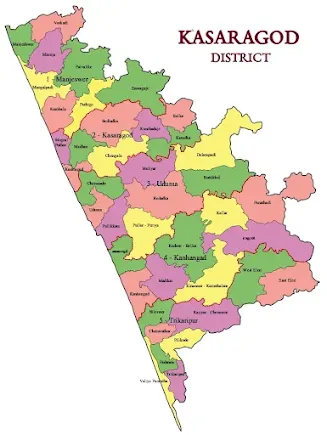



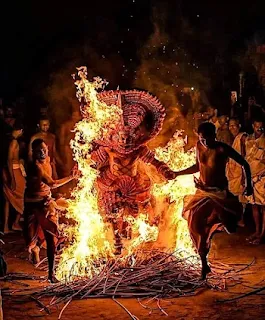
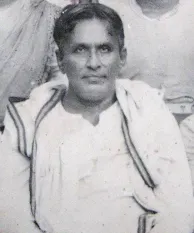
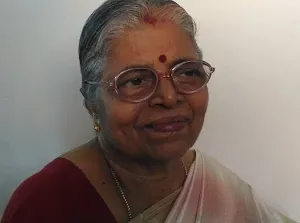
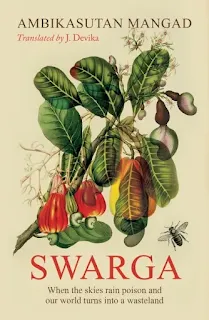


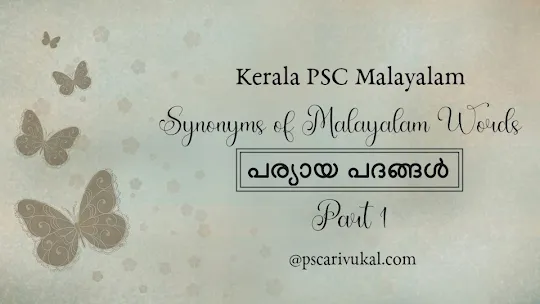




Post a Comment
Post a Comment